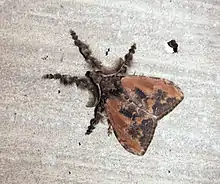Olene mendosa
Olene mendosa, the brown tussock moth or hairy tussock moth, is a moth of the family Erebidae. The species was first described by Jacob Hübner in 1823.[1] It is found in India, Bangladesh, Sri Lanka,[2] Indonesia, Taiwan, Thailand and Australia.[3]
| Olene mendosa | |
|---|---|
 | |
| Scientific classification | |
| Kingdom: | Animalia |
| Phylum: | Arthropoda |
| Class: | Insecta |
| Order: | Lepidoptera |
| Superfamily: | Noctuoidea |
| Family: | Erebidae |
| Genus: | Olene |
| Species: | O. mendosa |
| Binomial name | |
| Olene mendosa Hübner, 1823 | |
| Synonyms | |
| |
Description
Sexes show dimorphism with variable colour morphs. The wingspan of the female is about 46–54 mm, whereas the male's is about 30–40 mm. The adult male has two morphs. The common form is smoke brown with uniformly brown forewings and pale greyish hindwings. In the forewing, black specks and a pale patch outside the subbasal line can be seen.[4]
The adult female also has two forms with an areole on each forewing and they lack the white colored portions on forewings which is found on male. The common form has an irregular longitudinal dark brown zone in the center of forewing. The more rare form has pale colours. The underside of the wings are similar in both sexes with less pronounced markings.[4]
The full-grown caterpillar is 38–44 mm long. It is hairy with four white or brown dorsal tussocks. It is greyish brown with a crimson-reddish head, legs and prolegs. Head with red stripes found on full-grown caterpillar. Pupation occurs inside a silk cocoon spun between the leaves of the food plant.[5]
Pest
The caterpillar of this species is polyphagous and feeds on a diverse range of plant species. In India, the caterpillar has been recorded on crops such as Solanum tuberosum, Tamarindus indica, Citrus, Cedrus deodara,[6] Acacia nilotica,[7] Mangifera indica,[8] Camellia sinensis, Ricinus communis,[9] and Salmalia malabarica.[10] In Bangladesh, caterpillars were recorded on Sesbania aculeata and Bauhinia purpurea.[11]
Other common food plants of larva include, Ceiba, Durio, Terminalia, Raphanus, Shorea, Dipterocarpus, Aleurites, Excoecaria, Pelargonium, Saccharum, Sorghum, Zea, Cinnamomum, Careya, Arachis, Butea, Cajanus, Cassia, Dalbergia, Pithecellobium, Sesbania, Vigna, Lagerstroemia, Hibiscus, Zizyphus, Rosa, Populus, Santalum, Dimocarpus, Litchi, Nephelium, Schleichera, Achras, Palaquium, Melongena, Tectona,[12] Macadamia integrifolia, Persea americana, Terminalia carolinensis.
References
- "Species Details: Olene mendosa Hübner, 1823". Catalogue of Life. Retrieved 7 March 2018.
- Koçak, Ahmet Ömer; Kemal, Muhabbet (20 February 2012). "Preliminary list of the Lepidoptera of Sri Lanka". Cesa News. Centre for Entomological Studies Ankara (79): 1–57 – via Academia.
- "Brown Tussock Moth". Brisbane Insects. Retrieved 7 March 2018.
- "Olene mendosa Hübner". The Moths of Borneo. Retrieved 7 March 2018.
- Herbison-Evans, Don & Crossley, Stella (9 December 2015). "Olene mendosa Hübner, 1823". Australian Caterpillars and their Butterflies and Moths. Retrieved 6 October 2018.
- "Dasychira mendosa Huebner (Lepidoptera: Lymantridae) - a Report of New Pest on Cedrus deodara (Roxb.) G.Don. in Himachal Pradesh". Indian Forester Journal. Retrieved 7 March 2018.
- "Dasychira mendosa Hubner (Lepidoptera: Lymantriidae) - a new pest record on Acacia nilotica ssp. indica (babul) from Tamil Nadu". CABI. Retrieved 7 March 2018.
- "A Short Note on a Lymantrid Caterpillar (Dasychira mendosa) (? ) Hubn. Feeding on Mango Leaves". Journal of the Bombay Natural History Society. 1929. Retrieved 7 March 2018.
- "Biological note on Dasychira mendosa Hubn". Gujarat Agricultural University Research Journal. Retrieved 7 March 2018.
- "Dasychira mendosa (Lepidoptera: Lymantriidae) as a new pest of cotton (Salmalia malabarica (D.C.) Schott. & Nedl.) at Mannuthy, Kerala [1978]". Agricultural Research Journal of Kerala. Retrieved 7 March 2018.
- "Biology of Dasychira mendosa Hübner (Lymantriidae: Lepidoptera) polyphagous pest in Bangladesh". Agricultural Research Journal of Kerala. Retrieved 7 March 2018.
- Savela, Markku. "Olene mendosa Hübner, 1823". Lepidoptera and Some Other Life Forms. Retrieved 6 October 2018.
External links
- Development and reproduction of Dasychira mendosa (Lepidoptera: Lymantridae) on three species of Terminalia 1988
- "Dasychira mendosa". The Pherobase.